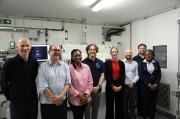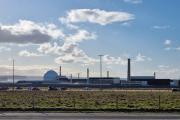Innovative Camera Records Final Sodium Removal
19th March 2008
Dounreay's Prototype Fast Reactor has now been drained of all 1500 tonnes of liquid metal that once flowed through its primary and secondary circuits.
The last batch of hazardous sodium has been transferred from the base of the reactor vessel and is now being destroyed in a purpose-built chemical treatment plant that extracts the radioactivity and converts the sodium to common salt that can be discharged safely to the sea.
It means the site has almost completed the destruction of one of the major hazards leftover from its research days.
PFR decommissioning manager James McCafferty said it had been achieved without a lost-time accident for more than three years.
"The team behind this achievement is drawn from several different companies but all had one thing in common - to deliver the removal of this hazard from the reactor to the highest standards of personal and environmental safety," he said.
Staff were able to see the last remaining few tonnes being removed from the bottom of the reactor by attaching a camera to a purpose-built pump that was lowered into the "heel" of the reactor vessel.
This was the most difficult part of the sodium to reach and required innovative design and extensive testing by the reactor clean-up team to develop a system that would clear the final pools of metal. It was the first time anyone has seen inside the vessel since its construction 40 years ago.
Attached to a steel hose, the camera assembly manoeuvred through the complex internals of the reactor to reach the very bottom. Operating in an extreme radiation environment with temperatures in excess of 200 degrees Celsius, it filmed the pump removing the final 20 tonnes from the mirror-like pool of sodium.
It has taken eight years to drain the reactor in a way that ensured the safety of the workforce and the environment was protected.
The final stage was completed using the innovative camera-pump device designed in-house by UKAEA's specialist design team. It was built by JGC Technical Services Ltd and operated by Nukem. Initially mock-ups were built and tested at the T3e facility at Janetstown where the whole assembly was also commissioned and the operators trained.
Billy Husband, alkali metal residues removal project manager at PFR, said: "Achieving this project is a major step forward in our programme to decommission PFR. We have worked on this particular stage of the project for two years and it has without doubt been a success due to the dedicated team of UKAEA and contractor staff working together."
Lead designer Robin Herrick helped with the deployment and operations. "Seeing the equipment in use is very exciting. To keep the camera cool way down at the bottom of the reactor vessel, I designed something akin to a 23-metre long flexible Thermos flask. It was a big challenge."
The lead operations engineer on this project is Evan Park, who also worked at PFR in its infancy and watched the sodium being loaded into the reactor in 1974. He said: "When I worked here during the construction of PFR I never thought I would be standing here today overseeing such a major phase of its decommissioning."
The removal of the sodium means the decommissioning team can now "steam-clean" the last traces of sodium from the pipework using a water vapour nitrogen process, making it safe to begin dismantling the entire system.
Related Businesses
Related Articles
UKAEA develops 3D printing for fusion components
At its recently opened Central Support Facility (CSF), UKAEA has commissioned an electron beam additive manufacturing machine that can be used to incorporate tungsten into components, alongside a selective laser manufacturing machine. Fusion can play a key role in a global low carbon energy future.Advancing Fusion Remote Maintenance: Industry Collaboration Driving Innovation
As part of the Fusion Futures (FF) programme, UKAEA's Remote Applications in Challenging Environments (RACE) has partnered with industry leaders to develop two groundbreaking technologies for remote maintenance in fusion energy engineering. Thanks to FF funding, industry has taken the lead in maturing UKAEA technology concepts—delivering real-world solutions that enhance operational autonomy and reduce maintenance burdens in extreme environments.UKAEA launches International Fellowships Scheme for fusion
UKAEA has launched the International Fellowships Scheme, an initiative to help expand the global talent pool supporting the fusion industry. The scheme is part of the UKAEA's Fusion Opportunities in Skills, Training, Education and Research (FOSTER) Programme, which aims to train, support, and empower the next generation of professionals, who will help deliver fusion power to the grid.Kyoto Fusioneering and Astral Systems join Culham fusion hub
UKAEA's Culham Campus welcomes Kyoto Fusioneering and Astral Systems as its latest tenants. Two pioneering companies, Kyoto Fusioneering and Astral Systems, have joined the growing cluster of fusion technology and AI organisations at United Kingdom Atomic Energy Authority's (UKAEA) Culham Campus.
Fusion-grade Steel Produced At Scale In UK-first
Researchers achieve 10x production cost savings for reduced activation steel. A United Kingdom Atomic Energy Authority (UKAEA) working group has successfully demonstrated the industrial scale production of fusion-grade steel.
UKAEA To Lead The Creation Of A Robotics And AI Cluster
UKAEA will lead the creation of a new £4.9m nuclear robotics and artificial intelligence cluster across Cumbria and Oxfordshire. The robotics and AI cluster was announced by UK Research and Innovation (UKRI) as one of seven new projects to kickstart economic growth and address regional needs: www.ukri.org The robotics and AI cluster will link Cumbria and Oxfordshire to accelerate the decommissioning of the UK's legacy nuclear fission facilities and keep people out of hazardous environments.
Diamonds Are Forever? World-first Carbon-14 Diamond Battery Made In Uk
The world's first carbon-14 diamond has been produced with the potential to provide power for thousands of years. Scientists and engineers from the UK Atomic Energy Authority (UKAEA) and the University of Bristol have successfully created the world's first carbon-14 diamond battery.
UKAEA Monthly Newsletter Latest Edition
Find out what has been happening at UKAEA in our monthly newsletter. Read about our recent activities and upcoming events.
UKAEA Newsletter - Edition 11 Published Today
Find out what has been happening at UKAEA in our monthly newsletter. Read about our recent activities and upcoming events.
Corwm Visits Dounreay Nuclear Site
Members were given an overview of the scale of the problem and challenges faced in the decommissioning of the site. In the last week of March 2024, several members of CoRWM led by the Chair, Sir Nigel Thrift, made the long journey up to the North of Scotland to visit the Dounreay nuclear site, now managed by Nuclear Restoration Services.
